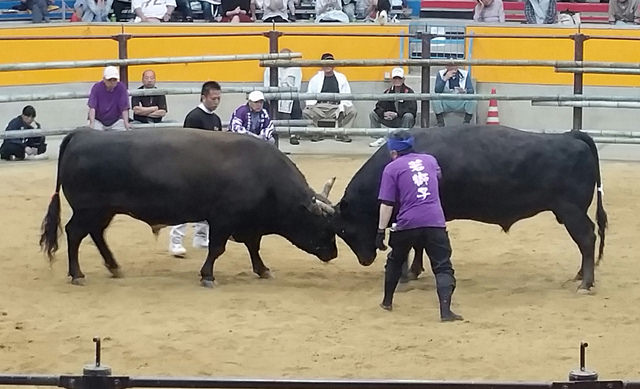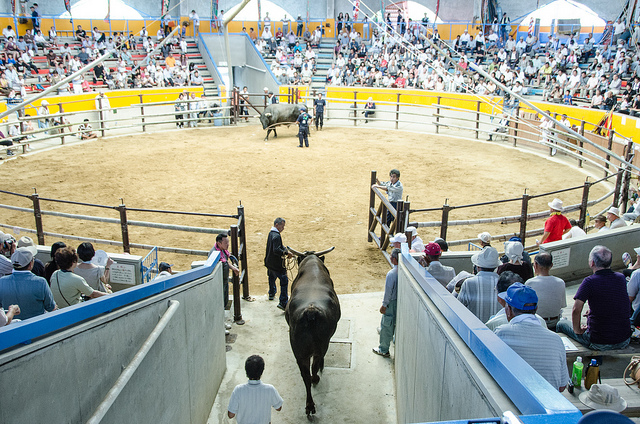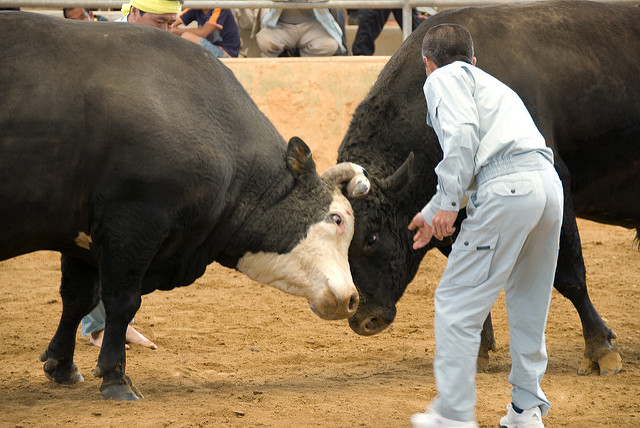
photo by kounotakeshi
Speaking of bullfighting, the first thing comes to your mind would be a Spanish matador and a bull. But did you know, Japan also has had bullfighting culture for long? Unlike Spanish one, Japanese bullfighting matches are between two bulls. Bullfighting is held in a few prefectures of Japan, and each of them has a long history. Spectacular fighting of powerful beasts held in a fenced circle is always popular among tourists as well as local residents. This column will introduce Japanese style bullfighting.
About Japanese bull fighting
Used in agriculture and transportation or even worshipped as a sacred animal, Bulls have been very familiar to Japanese people since the old times. Bullfighting is one of the forms derived from such a long time close relationship between bulls and the Japanese. In recent years, bullfighting is held in Kuji city of Iwate prefecture, Ojiya city and Nagaoka city of Niigata prefecture, Okinoshima-cho of Shimane prefecture, Uwajima city of Ehime prefecture, Tokunoshima of Kagoshima prefecture and Uruma city of Okinawa prefecture.
The majority of bulls used in Japanese bullfighting are Japanese shorthorn. While livestock bulls are castrated soon after birth, fighting-bulls kept uncastrated in order to maintain their fight instinct. They are carefully fed, cared and trained by trainers and start participating in matches at the age of about 4-years.
Match rules
During bullfighting matches in Japan, bulls lock horns to force each other to lose the will to fight. Just like Sumo tournaments of human wrestlers, there are techniques to defeat an opponent and grading of bulls such as Yokozuna and Ozeki. Match rules are slightly differ depending on regions. While there is no winner or loser in a certain region, a bull which give up ground first becomes a loser in other regions. Each bull is accompanied by a coach called “seko” who encourage the bull to win or make its position right during a match. Sekos are in charge of a very dangerous roles including standing right by fighting bulls or attaching hand rope on the bulls, therefore knowing their bulls very well is the most important thing for them.
Bull fighting in regions
Kuji, Iwate prefecture
Iwate has been well known for production of Nanbu-ushi that was commonly used for farming and transportation. Originally, bullfighting in Iwate started as a way to decide a head of group of bulls that transport salt during the Edo period. In Kkuji city, there are 3 bullfighting tournaments held in spring, summer and autumn.
Inquiry: Iwate Hiraniwa-kogen Togyu Association (Japanese only)
Nagaoka & Ojiya, Niigata prefecture
The origin of bullfighting in this area can be traced back to about 1000 years ago. In these two cities, bullfighting has been a religious service, not an entertainment. As it is to be dedicated to deities, there is no winners and losers in bullfighting matches in Ecihgo region. Each match last for about 5-minites and ends in a draw after bulls are separated by pulling reins attached to their legs. Also, bullfighting in this region has been designated as a significant intangible folk cultural asset. Regular bullfighting tournaments are held in between May to November.
Inquiry: Ojiya Tsunotsuki
Okinoshima, Shimane prefecture
Bullfighting in Okinoshima with a history of roughly 800-years, it is said that people if this island first started bullfighting to entertain grand emperor Gotoba who had been deported to this little island. This may be the reason why bullfighting in this island is held under an unusual rule, bulls are fighting with reins attached to their bodies. All the 3 main tournaments and regular tourism tournaments which are held May to September are very popular among tourists.
Inquiry: Okinoshima Town Tourist Association All Right (Japanese Only)
Uwajima, Ehime prefecture

photo by cotaro70s
There is no written evidence of the origin of bullfighting in this city, however, it was certainly established as a local entertainment. In addition to 5 regular bullfighting tournaments, there are tourism tournaments held between April to October. A bull that loses a will to fight first will be a loser under the local rule.
Inquiry: Uwajima Togyu
Tokunoshima, Kagoshima prefecture
In Tokushoshima-cho, Isen-cho and Amagi-cho of Tokunoshijma, roughly 45km south from Kagoshima city, bullfighting is a super popular entertainment of the entire community. It is also the best highlight of tourism here. It is said bullfighting in this city was originally started as a celebrating event of the end of harvesting season about 500 years ago. From January to October, a number of tourists and local audiences gather to watch bullfighting every year.
Inquiry: Tokunoshima Tourism Federation (Japanese only)
Uruma, Okinawa prefecture

photo by chrissam42
Uruma city is where bullfighting is the hottest ever with more than 10 regular tournaments per year. Bullfighting was completely established as a local entertainment here at latest in the Meiji period, and has been much loved by local residents since then. In 2007, the only indoor bullring dome “Ishikawa, Uruma-shi multi-purpose dome” opened so that spectators don’t need to care for bad weather.
Inquiry: Uruma-shi Economic Department business and industry Tourism Division
Sumo of bulls
Within a small circle of bullring, two splendid bulls lock each other’s horns. Bull owers, seko and trainers all stares at their fight in a tense. Fighting bulls weigh at least 700kg, the largest ones are over 1000kg. A crash of little-car-size bulls is absolutely the most spectacular view. Once you watch a match, your heart will be captured by a heated atmosphere of stadium.
